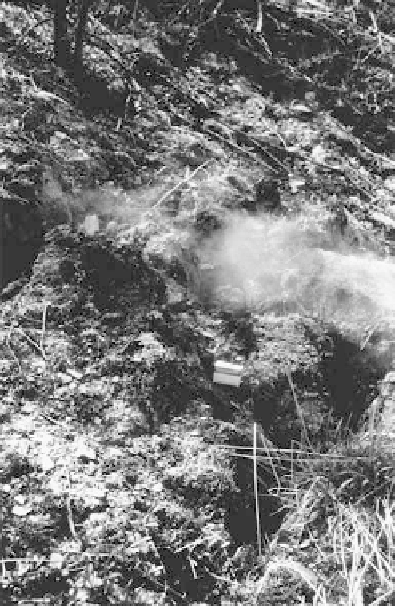Geology Reference
In-Depth Information
16.4. Locating Abandoned Mine
Fires
Smoke emitted from a surface fracture (film
for scale) at an abandoned mine in Large,
Pennsylvania. Surface expressions are
usually not good indicators of subsurface
combustion.
Photo: US Bureau of Mines, 1985.
Introduction
T
he emission of smoke and fumes at surface fractures and vents usually indicates a fire in an abandoned mine or
waste bank. Because hot gases follow the path of least resistance, the surface evidence of fires may not be related
by straight line paths to the source of combustion. The heated combustion source can be distant, laterally and
vertically, from the surface expression. Also, coal fires are usually confined to relatively small discontinuous areas
of smoldering combustion surrounded by large masses of insulating coal and rock.
A factor in the failure of many abandoned mine-fire-control projects is that the extent of the subsurface fire zone is
unknown when the project is planned. A corollary factor is that there is no adequate provision for monitoring the
propagation of the fire during and/or after the fire-control project. Conditions in the subsurface, which may be
unknown, also affect the application of an extinguishment method and the probability of success for most fire-
control projects. The Bureau of Mines developed a method to locate subsurface combustion zones and tested
several methods to determine subsurface conditions.
Mine-Fire Diagnostics
I
n order to locate a remote fire zone, it is necessary that (1) the fire have measurable characteristics, (2) the
characteristic be detectable, and (3) the data be interpreted correctly. The Bureau of Mines developed a mine-fire
diagnostic (MFD) methodology in which the measurable characteristics are the temperature, pressure, and hydro-
carbon concentration at the base of an array of boreholes. The sampling method uses an exhaust fan to impose a
pressure gradient to control the direction of flow of the mine atmosphere. The data are compared to an empirical
scale based on the laboratory determination of fire signatures.
The combustion signature used in the Bureau
s MFD methodology is a ratio based on hydrocarbon desorption from
coal. The low-molecular-weight hydrocarbons, methane through pentane, are adsorbed on the internal surface of
coal. At normal temperatures methane and a small percentage of higher hydrocarbons are desorbed. As the
temperature of the coal increases, the rate of desorption increases and the concentration of higher hydrocarbons
'





